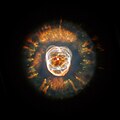Файл:Ngc2392.jpg
Перейти к навигации
Перейти к поиску

Размер этого предпросмотра: 600 × 600 пкс. Другие разрешения: 240 × 240 пкс | 480 × 480 пкс | 768 × 768 пкс | 1024 × 1024 пкс | 1500 × 1500 пкс.
Исходный файл (1500 × 1500 пкс, размер файла: 1,16 МБ, MIME-тип: image/jpeg)
История файла
Нажмите на дату/время, чтобы посмотреть файл, который был загружен в тот момент.
| Дата/время | Миниатюра | Размеры | Участник | Примечание | |
|---|---|---|---|---|---|
| текущий | 12:34, 28 июля 2005 |  | 1500 × 1500 (1,16 МБ) | Startaq | |
| 17:20, 1 февраля 2005 |  | 320 × 259 (12 КБ) | CWitte | Eskimo nebula |
Использование файла
Следующие 7 страниц используют этот файл:
Глобальное использование файла
Данный файл используется в следующих вики:
- Использование в af.wikipedia.org
- Использование в ar.wikipedia.org
- Использование в arz.wikipedia.org
- Использование в ast.wikipedia.org
- Использование в az.wikipedia.org
- Использование в be.wikipedia.org
- Использование в bg.wikipedia.org
- Использование в bn.wikipedia.org
- Использование в bs.wikipedia.org
- Использование в ca.wikipedia.org
- Использование в ce.wikipedia.org
- Использование в cs.wikipedia.org
- Использование в cv.wikipedia.org
- Использование в da.wikipedia.org
- Использование в de.wikipedia.org
- Использование в diq.wikipedia.org
- Использование в el.wikipedia.org
- Использование в en.wikipedia.org
- Planetary nebula
- Compact object
- Eskimo Nebula
- List of planetary nebulae
- User:Anticipation of a New Lover's Arrival, The/Galleries/Awards
- Caldwell catalogue
- Herschel 400 Catalogue
- User:Reginhild
- Wikipedia:Featured picture candidates/May-2007
- Wikipedia:Featured picture candidates/Eskimo Nebula
- User:Reginhild/Userboxes/Space Scientist
- Gemini (constellation)
Просмотреть глобальное использование этого файла.